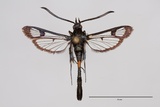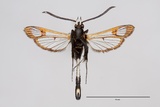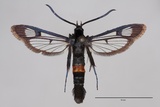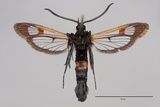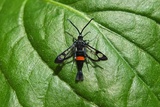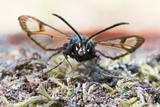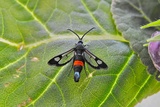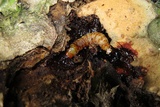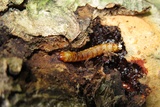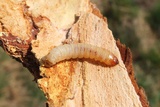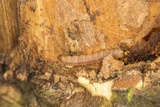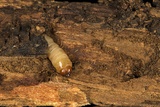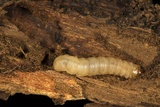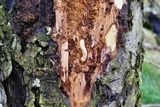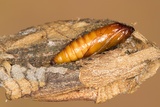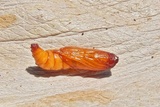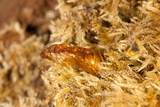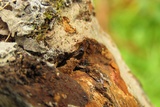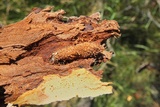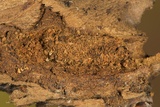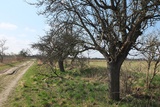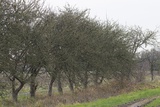Synanthedon myopaeformis (Borkhausen, 1789) Species
Last modified: Nov. 21, 2025, 7:05 p.m.
S. myopaeformis is not a rare species in Belgium and can be very common, especially in old orchards.
This species is considered Least Concern according to the IUCN Red List category for Flanders 2023.
Details
- Classification
- Family: Sesiidae > Subfamily: Sesiinae > Tribus: Synanthedonini > Genus: Synanthedon > Species: Synanthedon myopaeformis
- Vernacular names
- Appelwespvlinder (NL), Red-belted Clearwing (EN), Sésie du Pommier (FR), Apfelbaum-Glasflügler (DE)
- Synonyms
- Synanthedon mutillaeformis (Laspeyres, 1801)
- First mention in Belgium
- De Sélys-Longchamps E. 1837. Catalogue des Lépidoptères ou Papillons de la Belgique, précédé du tableau des Libellulines de ce pays. — — : 1–29. On page 21 (as Sesia Mutillaeformis). view page
- Status
-
Native
Distribution
Imago
S. myopaeformis is a medium sized species (14–26 mm). The fully black wings and the red band on the abdomen –which is very narrow in the males– are typical of this species. The base of the wings is not diffusely covered with orange-red scales as in S. culiciformis which is often confused with this species. The female is similar to the male but lacks the slender abdomen. The palps are ventrally pure white in the males and brown to black in the females which is another very useful characteristic distinguishing it from S. culiciformis. In the latter, the palps are ventrally bright orange. The proboscis is well developed and functional.
The males are freely attracted to the pheromone developed for this species and are best lured in early afternoon, although the optimal time span is very weather dependent.
Egg
The egg is elliptically shaped and light orange-brown.
Caterpillar
The caterpillar is off-white but is often found almost 'swimming' in sap of the tree. In these cases, the colour of the caterpillar can be more or less pink. The prothoracic shield is light brown and the head is darker brown. As in all Sesiidae, the prolegs have a double wreath of crochets.
Bionomics
The eggs are deposited in crevices in the bark near cankerous swellings, grafts or wound edges. The larva lives between the wood and bark often at the transition zone between dead and living tissue, often in a flat mine that is very moist because of the abundant plant juice. This sap frequently colours the larva with pink and brown stains. In Belgium, the larva of S. myopaeformis usually hibernates once but in unfavourable conditions a second wintering is possible. After wintering, a cocoon is constructed from gnawed plant particles spun together and with a silken lining. It is not uncommon for the cocoon is be located under semi-erect bark pieces.
Flight periods
The adults have been observed from mid-May till late August.
Observed on
- Host plant (species):
- Malus domestica
- Host plant (genera):
- Prunus, Pyrus, Malus, Crataegus and Sorbus
The larva lives under the bark of old fruit trees of the Rosaceae family, especially Apple, Malus domestica, but also other Malus species, Prunus spp., Crataegus spp., Sorbus spp. and Pyrus spp.
